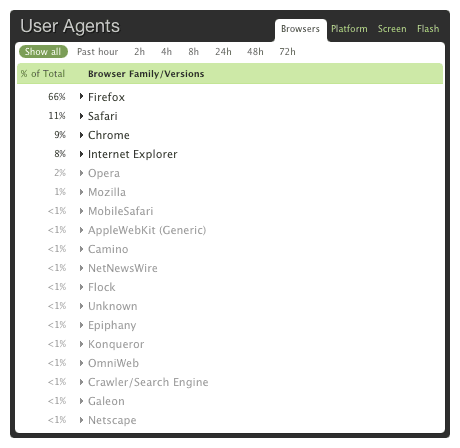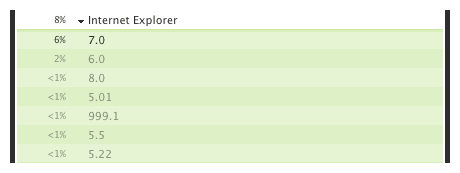I know traffic here is far from representative of the rest of the web. Regardless, I see an interesting trend developing. The numbers are drastic enough, I wonder if they prove the trend extends beyond the focus of Stopdesign and the type of people attracted to the content I post.
I’ve been following user agent stats for the past few years. It was only three years ago (January 2006) that Internet Explorer held the dominant percentage of aggregate traffic (70%+) on Stopdesign. Back then, Firefox was just over a year old. 1 I remember being impressed that Firefox had already gained 10–12% of traffic at that time. Apple’s Safari was just 2 ½ years old 2 and was hovering around 3–4% of Stopdesign’s traffic.
So that’s where we were then. IE dominated. Firefox trailed far behind in second position. This is where Stopdesign’s traffic is now:
* Stats represent the last 5 weeks or so of traffic for Stopdesign.com. Captured with Shaun Inman’s excellent website analytics package, Mint, via his User Agent 007 Pepper.
Chrome traffic is higher than normal because of the Recreating the button entry posted two days ago. My theory: Chrome users tend to be more heavily invested in Google products, so they’re attracted to content about Google. (Note: I don’t have access to data that backs this up, nor am I speaking on behalf of Google. But it’s a logical conclusion for anyone to make.) Thus the spike in Chrome’s percentage, which had been hovering around 2% prior to posting the button entry.
For those who care to see the IE breakdown, here are those numbers:
Sources:
- Mozilla.org: Mozilla Timeline
- Wikipedia: Safari (web browser): History and development


IE’s down to about 15% in our Mint stats, with Firefox leading, followed by Safari. Our site gets a lot of designer/developer attention, but is public-facing as well.
About time.
Interestingly, my numbers still put IE at close to 20% for the past month. Within IE, the numbers are similar, with IE6 still holding 28%. Once IE8 and Windows 7 are released, I think we may see a quicker shift. It’s one thing to be one version behind but two versions? Companies will wait about 6 months and then upgrade everything. So I say, by the end of this year.
Here are some different perspectives.
I develop on an ecommerce website that sells screen printing. It is marketed to the Boy Scouts and to music education groups. According to Google Analytics our user agent breakdown for January 2009 (791 unique visitors) is:
IE: 70.8%
Firefox: 21.87%
Safari: 6.45%
Chrome: 0.63%
I also work with http://www.jazzednet.org, which is the membership site for the Jazz Education Network. Their breakdown for January 2009 (1527 visitors):
IE: 40.8%
Firefox: 39.75%
Safari: 17.81%
Chrome: 0.72%
Target audience apparently has a huge impact on browser choice.
Thanks for sharing your stats info. Like Bill, I’ll share some data for perspective. I work for a company builds and hosts a pretty large number of custom real estate sites (around 200, I think.) I feel like that’s a pretty general interest market so the stats are pretty representative of adult users in the US. They are possibly skewed toward the 30+ demographic. Anyway, I’ve just surveyed a handful of our more heavily trafficked sites and found the following:
* Internet Explorer users account for between 65% and 85% of all visits
* Firefox and Safari account for almost all the rest of the traffic, and Firefox tends to have 2-3 times the share of Safari.
* 70% of IE users are browsing these sites with IE7. There was very little variation here, even though the percentage of IE users in general varied by 20% across sites.
The individual stats are interesting, however the general trend suggested by such data is inspiring: more people using better browsers! Hopefully things will look even better in another three years.
I work on a rather large national real estate site as well, and the web stats reflect what Scott said above.
Stopdesign and websites like it will have a different stats on browsers than websites that cater to a more representative population. I don’t think it’s fair to say that stopdesigns stats you posted prove a trend that extends beyond the focus of stopdesign. Unfortunately it can only prove the trend at this specific website :-)
Out of Interest, what is Internet Explorer 999.1? Someone remind Microsoft they’ve got another 991.1 versions to make before they get there.
I was wondering about these things while viewing my own stats (analytics). I have two sites that are used exclusively by university students (at McGill).
I figured my low IE rates were representative of my users, but I’m glad to see this is more universal than I first assumed.
I’m getting this (rounded):
FF: 55% (90%+ FF3)
IE: 24% (90%+ IE7)
Safari: 10%
Opera: 7%
Chrome: 5%
Also, university students these days use macs a lot more, I’m seeing 26% OS X. Linux has 5%.
I am not sure if this helps but here are some stats that I found interesting from Digital Web ..first a 3 year report then a last month report:
Last 3 years (02/06/06 to 02/06/09)
———————-
Firefox 48.31%
IE 36.76%
Safari 8.58%
Opera 2.91%
Mozilla 1.87%
Chrome .44%
Camino .39%
Mozilla Comp. .36%
Netscape .21%
Konqueror .12%
Last Month (01/06/09 to 02/06/09)
———————-
Firefox 52.30%
IE 29.78%
Safari 8.52%
Chrome 3.42%
Mozilla 2.83%
Opera 2.65%
Mozilla Comp. .17%
Camino .14%
SeaMonkey .05%
Konqueror .05%
Cheers,
– Nick
My own site averages IE still in the lead at around 60%, with Firefox at about 23% and Safari at about 13%. Other sites that I track are roughly similar, with IE varying between about 60 and 70%.
However, I agree with Ove that Stop Design’s audience is (as Doug stated in the original post) far from a typical demographic. The majority of visitors would, I presume, be web designers — and how many web designers use IE as their regular browser? A minority, I would suspect. The majority will of course be using Firefox if for no other reason than its extensibility and web dev tools. So that would explain FF’s freakishly high showing in the Stop Design metrics.
If you go to a sheep farm then of course you’ll see lots of sheep, but that doesn’t mean that cows are dying out just yet.
(Bees, of course, are another story altogether).
I think a lot of web designers wouldn’t touch IE after the many episodes of utter frustration toward the browser. I would think it’d be painful for anyone who has ever written a web page that attempts to support IE wouldn’t touch it with a 20 foot pole in their spare time.
I don’t support IE6 for any of the sites I’ve built recently because the demographic is too small and the time invested too great. I feel it’s our responsibility to end this IE6 thing. People using that browser should come across several messed up sites in a day to make them convert. I’m going to start applying an IE6 test that explains how bad the browser they’re using is, suggesting one of the WebKit browsers or IE7 (with a stern warning against it!)
Anonymously in case I get myself in trouble for revealing sensitive data, but here is the breakdown for our 1-million-pageviews-per-day travel site:
Internet Explorer 7.0: 52.04%
Internet Explorer 6.0: 23.49%
Firefox 3.0: 15.66%
Safari 525: 2.71%
Firefox 2.0: 2.63%
Chrome 1.0: 0.73%
(I believe Safari 525 is version 2.1. Obviously the Firefox figures will be split between Windows and Mac.)
So that’s more than three-quarters of our traffic still using Internet Explorer, and a third of that is still IE6.
Really nice news. Glad to know that less people are using IE today.
January is a very different story here in the UK. The rough breakdown for a UK-based site aimed at librarians and administrators in higher and further education (with some secondary ed thrown in) shows IEs continued dominance. This probably reflects institutional purchasing patterns and support systems. Most institutions purchase from a single vendor as much as possible and users have very limited access rights to modify their setup.
January 2009 / 2008
IE 66% / 76%
Firefox 27% / 20%
Safari 5% / 3%
Chrome 2%
IE 2009 / 2008
IE7 72% / 43%
IE6 27% / 56%
IE8 1%
Hi Guys,
the browser stats are something that I follow quite religiously, and the figures that you mention above are quite typical for my webmaster centric sites, however my main site is an entertainment based ecommerce website, and is mainly popular with 25-34 year olds in professional or managerial jobs, and 95% in the UK (Im serious about my stats)…
And on this site, the IE traffic far outweighs anything else:
Internet Explorer 1,656,366 78.22%
Firefox 337,743 15.95%
Safari 90,057 4.25%
Chrome 16,924 0.80%
Opera 10,650 0.50%
these are the browsers as recorded in google analytics for the last 30 days rolling. so by my assumption here FF has a long, long way to go before it can boast market dominance.
cheers
MOGmartin
I think this says more about the web design crowd than it does about the web browser market. Overall, IE holds close to 70% of the market, even if they make up only 28% of the hits on my blog.
I’m curious though: Are your OS stats also similarly skewed? Macs have been getting around 10% if you count iPhone hits – are you seeing more Mac users?
@all – Thanks for sharing your numbers for general sites. However, I was trying to point to something a little more specific. The implied trend I’m seeing is that the majority of web designers and developers have switched what they were using as their primary browser. Certainly, Stopdesign doesn’t attract every web designer or developer on earth. But it’s representative of a portion of the industry. The traffic numbers are based on a substantial number of unique visitors, so I thought those percentages were worth calling attention to.
Overall, the point I think I’m trying to make is a little obvious. But it’s also backed up by some numbers now. Seems like the “creators” (if you will) of web content have largely switched away from IE. And that we’re starting to see a true difference in the browsers used by the creators vs. the pure consumers of web content.
I agree. I think, it’s obviously too. A creator is – or better – should be always a step ahead in question of web technologie than a normal user. To do so, you’ll use the best plattform currently available.
Yesterday it was IE, today FF, tomorrow … who knows.
Frankly spoken, the time IE as the undisputed king on the browsermarket were expired 2 years ago. Until that time IE were stable, faster and had the better implementation of W3C Standards. Not mention the great developerment tool, too. But after, Microsoft were running in place with future improvement.
That time, the Firefox Browser came up with better implementations and pioneering improvements. The big bang for Microsofts IE and a slap for the develoment quad.
However, Firefox still has the nose ahead. Today the advantage may be small compare to IE, but that is what you see in your statistics.
regards Martin